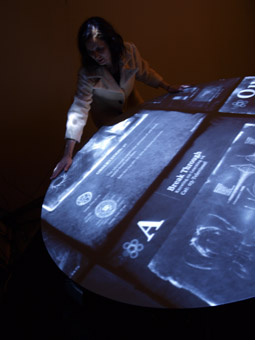animating the interactive spin
greg hooper: knowmore (house of commons), state library of queensland

KNOWMORE (House of Commons)
THE STATE LIBRARY OF QUEENSLAND IS A NICE ENOUGH BUILDING DOWN BY THE EDGE OF THE BRISBANE RIVER. ON THE GROUND FLOOR IS THE INFOZONE, WHERE YOU CAN LOOK ACROSS TO THE CBD OR JOIN THE TOURISTS AND CHAT OVER A LAPTOP WHILE USING THE FREE WIFI. JUST INSIDE, NEAR THE FRONT AND ON THE LEFT, A SECTION IS ENCLOSED WITH DRAPES THAT LOOK A LITTLE LIKE BLACK HOSPITAL CURTAINS. IN FRONT OF THE DRAPES A SIGN ON A CHROME STAND INVITES THE PASSER-BY TO HAVE A LOOK AT KNOWMORE (HOUSE OF COMMONS).
Brush past the curtains and into a space that is darkish, but not too dark, because the curtains don’t go all the way to the floor and they are not thick enough to block out all the light anyway. A round cafe-size table, for four to six persons, takes up the centre. There’s enough room to walk around it, but it’s still pretty cosy. An overhead projector hangs above, pointing onto a mirror at just the right angle to reflect the projection onto the dark top of the table. There’s a spatial sound set-up too, although I don’t really notice the speakers at all.
The installation is operated by grabbing the edge of the table and giving it a spin. Clockwise or anti-clockwise, either way is fine. Give it a spin and the graphics on the table become animated. Move around the table and the graphics change. There are five different scenes and each scene gets its own slice of the table-as-pie, with a little overlap and overlay at the slice boundaries. The overlap adds to the smoothness of the experience—no jumps from scene to scene. The sound seems to change as well, although the changes are not particularly dramatic or obvious. Again, this adds to the coherence of the experience.
The graphics are great—first up I’m seeing some acid green polyps, chasing each other around and around the table, flagella beating away behind them, tentacles fluffing about in front. They twist and turn, and the faster the table spins the more it acts like a centrifuge, driving the polyps outward to the edge. There is a genuine sense of watching something alive and swimming in a current controlled by the lazy-Susan spin of the table.
Another scene and another biomorphic form—circular, symmetric, hairy with cilia, more varied in colour than the polyps. I spin faster and the image speeds up and zooms to cover all the table surface. The physics of the animation is great—utterly natural in the way the cilial hairs are pulled out straighter and straighter as the speed increases. But it is the clarity of the interaction that stands out. There is no apparent lag between giving the table a spin and seeing changes in the animation—the table is beautifully engineered and the interface between table and animation is completely transparent.
Rather than imitating life forms, the next two animations show particles and clouded shapes sucked down into the centre, faster and faster with the table spin. These two sections don’t work as strongly for me, the interaction is less direct—the table spins around but the animation works radially across the spin, from the edge to centre.
Moving around the table a little more and we see a faded database on old style microfiche—blue grey images and defocused text. Now the table spin moves our view on to the image, like driving crosshairs with a shuttle wheel. Spin one way for the X-axis, reverse the spin for Y. There’s a nostalgia evoked by the monochromatic microfiche that is reinforced by arranging the information into cells. It’s like the periodic table of elements with micrographs and quasi-elementary chemical symbols: Er for Erbium, and Ke for… what? But the nostalgia is not just for a look, but for a system of knowledge based on recording, codifying, naming—partitioning the phenomenal world into atomic events.
I play some more, spinning and slowing, trying to make out the images, reading the grainy cells where I can: “Observation 03: the action of language and knowing are of different registers”; “Observation 06: the should of conduct exists in relation to a crisis in conversations rather than an embodiment of concern.”
As I read the information in the database cells the animation slows, the direction changes. Text and image ripple like flowing water, then submerge completely. A few more steps around the table and the polyps emerge again—a few living cells chasing each other, as at the beginning.
Keith Armstrong describes KNOWMORE (House of Commons) as concerned with common interest and empowering through embodied knowledge and communal action. However this was not obvious from my interaction with the work. ‘Spin’ is an unusual choice for physical interaction. The movement of the spinning hand is across the body and works against primary gestures of incorporation and repulsion.
However, perhaps working against the poetic engagement of the sole user is a strength of the work. KNOWMORE (House of Commons) is an installation that is meant for small groups of users. One can imagine a forward and backward tussle between the various people over which way the table spins, and who gets to spin it. A negotiated and dynamic exchange of control will emerge and bring the underlying concerns of ‘common interest’ deeper into the experience. As the only person using the installation perhaps I missed that negotiation, that deeper meaning. Perhaps playing alone is not supported at this time.
KNOWMORE (House of Commons), interactive installation, directors Keith Armstrong, Chris Barker, visual artist Stuart Lawson, Quest3D author Darren Pack, sound design Luke Lickfold, Infozone; State Library of Queensland, Brisbane, Feb 21-May 24; www.embodiedmedia.com
RealTime issue #90 April-May 2009 pg. 34






